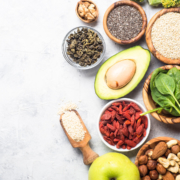How Seasonal Eating Improves Your Health (& Helps the Earth)
Have you ever tasted the sweetness of a freshly picked strawberry? Or bitten into a juicy, homegrown tomato straight off the vine? If so, you know the delights of seasonal eating. Our ancestors ate this way naturally. They didn’t need a seasonal eating guide with instructions. Eating with the cycles of nature was their only option.
Nowadays, there’s a bevy of food options at your disposal all year long. So many people get in the habit of eating the same foods on repeat. This not only limits nutrient intake but gets you out of sync with nature. Seasonal eating guides us back to eating how nature intended.
What is Seasonal Eating?
Simply put, seasonal eating means eating food around the time of year it’s naturally harvested. That means summer is berry season, and in the fall, it’s time for squash. Food grown around its natural harvest time yields benefits for your health, the planet, and society as a whole. But before we dig into that, let’s explore the roots behind eating seasonally.
Where Did the Idea of Seasonal Eating Come From?
While seasonal eating may be trendy, the idea is nothing new. It has roots in several holistic healing systems — some dating back thousands of years!
Ayurveda
Ayurveda, an ancient Indian healing system dating back 3,000 years, translates to “knowledge of life.” Ayurveda recommends holistic lifestyle interventions and remedies that foster balance between body, mind, spirit, and the environment.
Ritucharya (Sanskrit for “seasonal regime”) is an Ayurvedic concept promoting living and eating in harmony with the seasons. Practicing Ritucharya means being aware of how changes in the weather affect the body. By adjusting your foods seasonally, you harmonize with nature. Per Ayurveda, this not only promotes health but prevents future illness.
Traditional Chinese Medicine
Traditional Chinese Medicine (TCM) is an ancient medical system used for over 2,000 years. It maintains that a life force energy, known as qi (pronounced “chee”), animates each person. When qi is flowing freely, it allows the body’s two opposing forces, yin, and yang, to stay balanced.
TCM views eating seasonal foods that grow in your environment as one way to help your body harmonize with nature. That means eating foods that nourish yang in spring and summer and yin in fall and winter. The idea is that by eating with nature, you’re better able to adapt to the changing seasons and stay healthy all year long.
Biological Medicine
European Biological Medicine is a holistic healing system that believes each body has the innate ability to heal itself naturally.
Rather than treating disease by managing symptoms, biological medicine supports the body’s healing system to function optimally. Much of this is done through proper nutrition and cleansing the body of toxins. Eating seasonal food is a simple way to reduce toxin exposure while flooding your body with nutrient-dense food.
Functional Medicine
Like biological medicine, functional medicine is a holistic healing system that focuses on identifying the root cause of illness. It views food as medicine and espouses eating a diverse diet filled with organic, nutrient-dense foods. Seasonal eating is a simple way to do just that.
What are the Benefits of Eating Food in Season?
While having every food under the sun available 365 days a year is handy, it gets us out of tune with the cycles of nature. Eating seasonal food restores that natural rhythm and offers numerous health, environmental, and social benefits.
Health Benefits of Seasonal Eating
Seasonal food is not only fresher and tastier than mass-produced food; it offers more nutrients. When seasonal fruits and veggies are grown locally, they are picked when ripe, and nutrients are at their peak. For example, one study found that broccoli grown in the fall has nearly twice the vitamin C content as broccoli grown in the spring!
On the other hand, mass-produced food is harvested early to survive the lengthy shipping process. Each day in transport means more nutrient loss. In fact, a study out of Penn State shows that spinach loses nearly half of its nutrient content after eight days of refrigerated storage.
Plus, seasonal food just tastes better. Mass-produced food uses artificial ripening agents that manipulate the ripening process. Often conventional produce spends weeks and even months in storage or transport before hitting shelves. Since seasonal food is typically grown locally, it’s picked when it’s at its freshest — often within days of it landing on your plate! Eating seasonal foods also means less exposure to harmful pesticides, preservatives, and other chemicals.
Environmental Benefits of Seasonal Eating
As we just touched on, most food in the US has a long trek before hitting store shelves. In Michael Pollan’s book The Omnivore Dilemma, he explains, “The typical fruit or vegetable on an American’s plate travels some 1,500 miles to get there, and is frequently better traveled and more worldly than its eater.”
All that food transport has disastrous effects on our carbon footprint. Plus, growing food outside of its natural season requires fossil fuels and large amounts of water. For example, if you want to grow strawberries in the dead of winter, you need to recreate summer heat artificially. That’s going to take a massive amount of energy compared to growing berries naturally in the summer sun.
Not to mention, eating more seasonal food means fewer encounters with pesticides and other harmful chemicals. This lightens your toxic load and the planet’s as well.
Social Benefits of Seasonal Eating
Eating seasonal food often goes hand in hand with eating locally. That means your hard-earned dollars go towards supporting local farmers and, in turn, the local economy. As an added bonus, you get peace of mind knowing where your food came from and how it was grown.
An easy way to build the habit of seasonal eating is to make weekly trips to your local farmers’ market. You could even consider joining a CSA (community-supported agriculture), where you get weekly farm-fresh produce in exchange for a membership fee. Over time, this helps you form connections with your local community and get more in touch with the cycles of nature. This may help you slow down and have more reverence for the food on your plate.
Seasonal Eating Guide: How to Get Started
Farmers’ markets and CSAs are easy places to start your seasonal eating journey. However, if they’re not available in your area, don’t despair. This online seasonal eating guide reveals exactly which foods are in season each month in your area. Simply enter your state and the time of year, and you’ll get a list of seasonal foods to add to your grocery list.
Zeno said, “The goal of life is living in agreement with nature.” Practicing seasonal eating allows our bodies to reattune to nature, impacting our health, community, and planet. It all comes down to limiting the amount of stress we put on all our systems and using our energy efficiently.

Disclaimer: The statements made in this article have not been evaluated by the Food and Drug Administration. Any products or treatments mentioned are not intended to diagnose, treat, cure, or prevent any disease. Please consult a licensed medical practitioner for medical advice.
At Innovative Medicine, we believe in transparency. We want you to know that we may participate in affiliate advertising programs pertaining to products mentioned herein.
See how we can help you restore complete health of body, mind & spirit.
Join our mailing list and receive exclusive offers + information!







Leave a Reply
Want to join the discussion?Feel free to contribute!